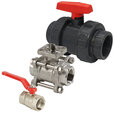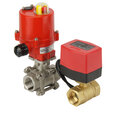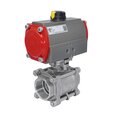Plumbing Ball Valve
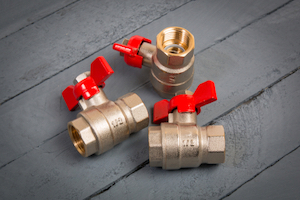
Figure 1: Brass ball valves are common in plumbing systems
Plumbing ball valves are shut-off valves used to control the flow of liquids and gasses in plumbing applications. These valves are often chosen due to being reliable, easy to operate, and inexpensive. This article gives a further overview of how ball valves work, how they are used in plumbing, and how to select ball valves for plumbing applications.
Table of contents
- What is a ball valve?
- Types of ball valves in plumbing
- Advantages over other valve types
- Selecting a plumbing ball valve
- FAQs
View our online selection of ball valves!
What is a ball valve?
A ball valve is a quarter-turn valve - the stem turns 90° to fully open or close the valve - that controls the liquid flow in a plumbing system. The ball in the valve is cored. When the hole in the ball is perpendicular to the ports (Figure 2 top), the valve is closed, and flow is blocked. The valve opens when the hole is parallel to the ports (Figure 2 bottom), allowing the flow. A plumbing ball valve's flow direction is bi-directional and can be installed horizontally or vertically. Learn our overview article to learn how ball valves work.
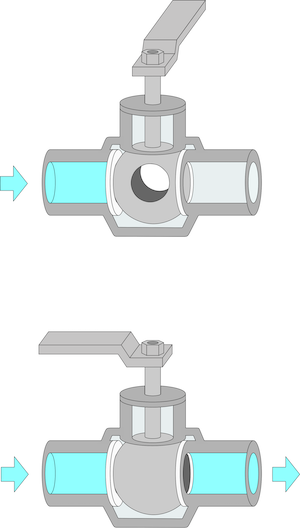
Figure 2: Flow is blocked when the ball's core is perpendicular to flow (top) and allowed when the ball's core is parallel to flow (bottom).
Why is a ball valve used in plumbing?
Ball valves have a long service life and reliable sealing over the life span, even if the valve goes unused for an extended period. This makes ball valves more popular in plumbing systems than other shut-off valves, such as gate valves, which take much longer to operate and are more prone to leakage. Read our gate valve vs ball valve article to learn more.
How ball valves are used in plumbing
Ball valves are used in several different types of plumbing systems and applications, including the following:
- Drainage systems
- Water supply lines
- Irrigation systems
- HVAC systems
- Fire protection systems
- Swimming pool plumbing
- Water heaters
- Gas lines
Types of ball valves in plumbing
The three types of ball valves often found in plumbing systems are full port, reduced port, and multi-port ball valves.
- Full port: The hole in the ball aligns in size with the inlet and outlet ports. This means low resistance to flow and minimal pressure drop.
- Reduced port: The hole in the ball is smaller than the inlet and outlet ports. This leads to higher pressure drop than full port versions but also allows for greater flow control.
- Multi-port: Multi-port ball valves allow more than one input and output flow through the valve. In plumbing systems, these valves are often used in filtration systems to control water flow to different parts of the system.
Learn more in our ball valve port design article.
Advantages over other valve types
In plumbing systems, ball valves have the following advantages over other types of shut-off valves:
- Installation: Ball valves have a straightforward and inexpensive installation process. Read our ball valve installation article to find out more.
- Maintenance: Ball valves are relatively durable, and the maintenance they require is simple.
- Water hammer: When closed slowly and smoothly, ball valves can greatly reduce the impact of water hammer.
- Reliability: Ball valves work reliably, even if used infrequently, and have relatively long lifespans.
Selecting a plumbing ball valve
To select the right ball valve for a plumbing application, consider the media's flow rate, max operating pressure, and max operating temperature. These factors will help determine the size of the valve and which materials to select.
- Actuation type: Manually actuated ball valves are typical for residential and commercial plumbing systems. Manual valves are cost-effective and simple to operate. Specific models have a flange according to the ISO 5211 norm and are compatible with electric actuators. Automated industrial applications may use electrically or pneumatically actuated ball valves.
- 2-way/3-way: 2-way valves are used for simple on/off control of flow. 3-way valves allow for flow diversion or mixing. L-port valves direct flow between two outlets, while T-port valves can connect three different flow paths.
- Flow rate: A ball valve needs to be sized correctly to ensure the proper flow rate. An oversized ball valve leads to unwanted pressure drop and can cause cavitation. An undersized ball valve will lead to insufficient fluid getting to the application. To learn more about flow rate, read our valve sizing calculator article.
-
Connection size and type: The connection size must match the piping system to prevent leaks and ensure proper flow. Threaded fittings, such as NPT and BSP, are standard end connections for ball valves in plumbing applications. Soldered connections are used for higher-pressure applications. For ease of installation, look into push-in fittings in our fluid control fittings article. Ball valves with a hose pillar end are suitable for flexible hose connections.
- Example: The following are approximations of flow rate and plumbing ball valve size on a water pipeline to a heating radiator (Figure 3). These values may change slightly based on the specific system and pressure.
- The typical port sizes of plumbing ball valves on the pipeline for a heating radiator are 15 to 20 mm (0.5 to 0.75 inches).
- The average flow rates of these plumbing ball valves are 11.4 to 22.7 LBM (3 to 6 GPM) and 30.3 to 45.4 LPM (8 to 12 GPM), respectively.
-
Housing materials:
- Brass: Brass is preferred for general residential plumbing applications. Brass offers good corrosion resistance and is suitable for water and non-aggressive media. Brass is less costly compared to stainless steel.
- Stainless Steel (SS): Stainless steel ball valves valves have excellent corrosion, pressure, and temperature resistance. This makes them ideal for industrial plumbing applications with high pressure and temperature ratings or high hygiene demands. However, stainless steel ball valves are not necessary for most, if not all, residential and commercial plumbing applications. Stainless steel ball valves are more expensive than brass and PVC ball valves. Read our article on ball valve materials to learn more.
- Plastic (Eg: PVC, PP): Plastic materials are lightweight and resistant to various chemicals, so they are suitable. They are ideal for low-pressure applications involving chemicals, such as swimming pools.
-
Seal materials:
- NBR: NBR seals operate up to 60 °C (sometimes 80 °C) and 17 bar (250 psi).
- EPDM: EPDM seals are preferred for drinking water because they do not affect the water's taste. These seals operate up to 150 °C (302 °F) and 24 bar (350 psi).
- Temperature and pressure ratings: Ensure the valve can operate within the system's temperature and pressure range, which depends on the valve materials. A brass ball valve's seals will fail due to high pressure or temperature before its body does. PVC, though, begins to deform at 60 °C (140 °F). A valve rated for -20 𐩑C to 100 𐩑C (-4 𐩑F to 212 𐩑F) and 10 bar (145 psi) is typically suitable for most water applications.
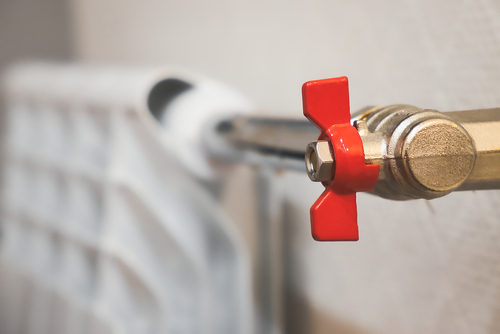
Figure 3: A ball valve on a water pipeline to a radiator.
FAQs
What is a ball valve in plumbing?
A ball valve in a plumbing system has a cored ball that aligns with the flow path to allow flow and moves perpendicular to the flow path to block flow using the body of the ball.
Where is a ball valve used in plumbing?
Ball valves are used throughout plumbing systems, from small PVC valves under a sink to high-pressure ball valves in industrial plumbing systems.




